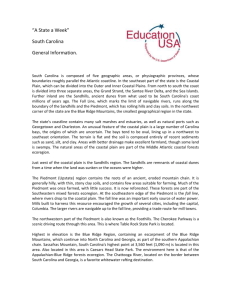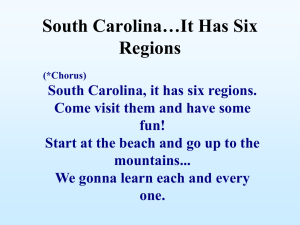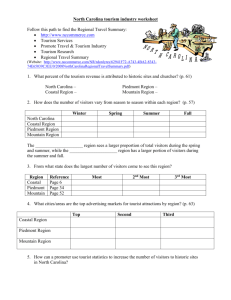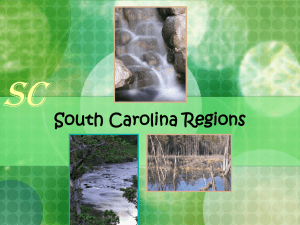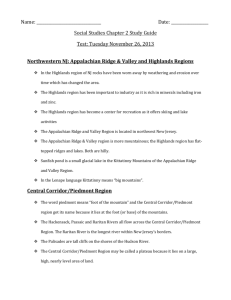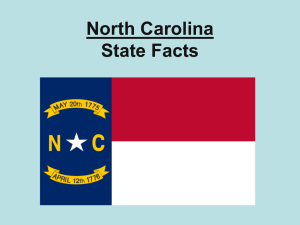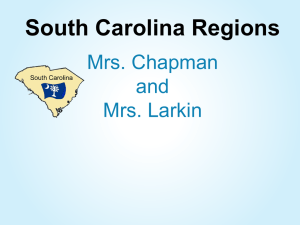Regional Diversity
advertisement
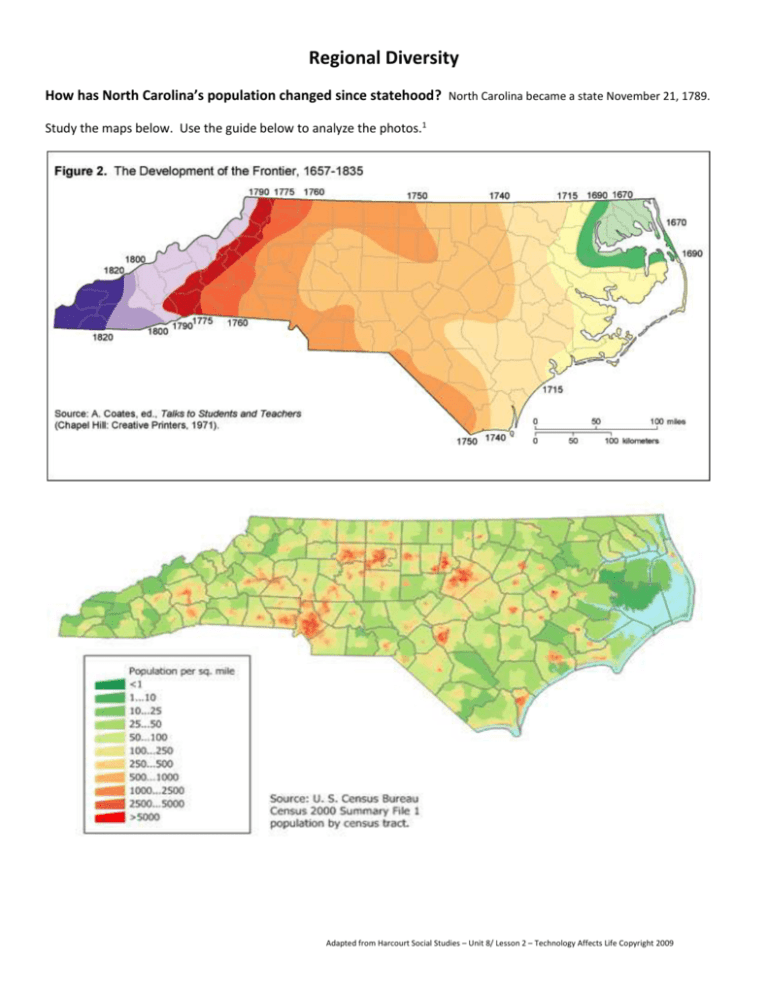
Regional Diversity How has North Carolina’s population changed since statehood? North Carolina became a state November 21, 1789. Study the maps below. Use the guide below to analyze the photos.1 Adapted from Harcourt Social Studies – Unit 8/ Lesson 2 – Technology Affects Life Copyright 2009 Observe Reflect Question Further Investigation 1 Library of Congress - http://www.loc.gov/teachers/usingprimarysources/ Each region of North Carolina is unique. The history and geography of each region affect how people there live, work, and govern themselves. Native American populations inhabited North Carolina from pre-historic times. For more information on early native peoples of North Carolina you can listen to the podcast at ncpedia.org. http://ncpedia.org/history/early/nativesettlement Adapted from Harcourt Social Studies – Unit 8/ Lesson 2 – Technology Affects Life Copyright 2009 Living on the Coastal Plain People on the Coastal Plain live in many different communities. Most are small. Some, such as New Bern, were founded almost 300 years ago. Wilmington is the state’s busiest deepwater port. Deepwater ports are able to handle large cargo and container ships. Morehead City, founded in 1853, is another deepwater port. They are the only deepwater ports on the coast of North Carolina. Several Coastal Plain communities grew because of their location near military bases. In 1918, Fort Bragg, an Army base, was built near Fayetteville. Joining this base were Pope Air Force Base, Seymour Johnson Air Force Base and Air Station Elizabeth City with the Coast Guard. Marine Bases include Camp Lejeune, Cherry Point and New River. All of these bases make North Carolina in the top five for states that host military bases. People living on the Coastal Plain sometimes face hurricanes. Hurricanes are huge rotating storms with wind speeds of 74 miles an hour or more. Hurricanes form over ocean waters starting off the west coast of Africa. Even though they start on water, their movement over land can cause major property damage and loss of life when they reach shore. New satellite technology gives communities time to prepare. Often communities and religious groups work together to prepare for hurricanes. They provide safe shelters and help people recover after the storm. Working on the Coastal Plain Many Coastal Plain jobs are tied to the region’s resources. For centuries, people have worked in industries such as fishing, farming, and forestry. Today, fishing remains a major industry on the Coastal Plain. Fish and shellfish are caught in coastal waters and are also raised on fish farms. Agriculture is still one of the region’s top industries. Today, farmers raise many different types of crops and livestock. Many of their products are shipped to other states. In the past, colonists used the Coastal Plain’s forests to make materials for shipbuilding. Today, these forests are used mainly to make wood products and paper. Adapted from Harcourt Social Studies – Unit 8/ Lesson 2 – Technology Affects Life Copyright 2009 The Coastal Plain also has many service workers, people who do jobs or activities for other people for pay. Service workers include teachers, bankers, government employees, and workers in the tourism industry. Living in the Piedmont More people live in the Piedmont than in any other region of North Carolina. Large urban areas, including the Triangle, the Triad, and Metrolina are located in the Piedmont. Metrolina covers 12 counties in North Carolina and South Carolina. At the center of Metrolina is the city of Charlotte. Charlotte is North Carolina’s largest city. The city has many highways and railroads and the state’s largest airport. Over times, Charlotte has become a transportation hub for the southeastern United States. A hub is the center of a business or industry. Charlotte is also a center for banking. The state capital, Raleigh, is also in the Piedmont. As a result, elected state officials live and work there at least part of the year. Most state government offices are also located there. The Piedmont is also a center of higher education. Many of the state’s colleges and universities are located in the region. Thousands of students attend these schools each year. Adapted from Harcourt Social Studies – Unit 8/ Lesson 2 – Technology Affects Life Copyright 2009 Working in the Piedmont Many people in the Piedmont earn their living through manufacturing. They make products including chemicals, electronics, machines, pharmaceuticals and medicines. Textiles, furniture, and tobacco are other important industries in the region but have declined in recent years. Tobacco manufacturing is still an important industry in the Piedmont. But because of health risks, fewer people buy tobacco products today. As a result, some tobacco companies have purchased other companies. Instead of tobacco, these companies make other kinds of products, such as food products. Some tobacco farms in the region now grow crops such as grapes. Many service workers in the Piedmont work in state government. Their jobs include taking care of public health issues and working to protect natural resources. Adapted from Harcourt Social Studies – Unit 8/ Lesson 2 – Technology Affects Life Copyright 2009 Living in the Mountains There are more than 200 communities in the Mountain region. Many have no more than a few thousand people. Some western North Carolina towns such as Asheville and Hendersonville have grown in recent years. Asheville, with more than 70,000 people, is the region’s largest city. People are attracted to the Mountain region because of its natural beauty and mild climate. Many artists call the area home, as do college and university students. Galleries throughout the region display and sell local artwork. The region also has many retirement communities, places where some people live when they no long work at full-time jobs. The Mountain region is a popular vacation spot. Tourists began visiting the region in the late 1700’s. Over time, many resorts were built for visitors in the mountains. Today, there are many vacation destinations in the Mountain region. The towns of Boone, Banner Elk, and Blowing Rock are located near popular ski resorts. Working in the Mountains People in the Mountain region rely on industries tied to the region’s resources. manufacturing, and the service industry are important to the region. Farming, mining, forestry, Mountain farmers raise fewer crops than those on the Coastal Plain. Apples, Christmas trees, tobacco and a growing wine industry are crops of the region. Farmers also raise beef and dairy cattle. Most of North Carolina’s mines are located in the Mountain region. More feldspar, lithium, olivine, and mica are mined in North Carolina than in any other state. As in the Coastal Plain, the Mountain region’s forests are used to make wood products and paper. In addition to paper, factories in the region make furniture and process foods. The most important industry in the Mountain region is tourism. The Blue Ridge Parkway alone is visited about 20 million times a year. Tourism provides jobs for thousands of people in the Mountain region. Adapted from Harcourt Social Studies – Unit 8/ Lesson 2 – Technology Affects Life Copyright 2009

